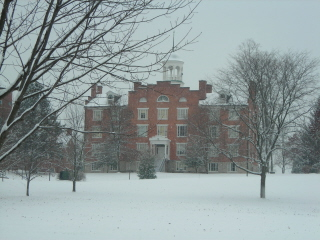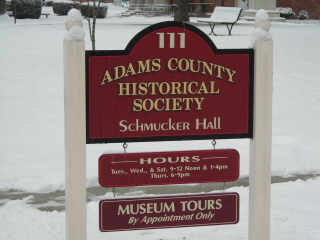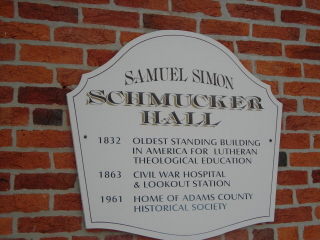Brian Jordan ’08 interns at the Adams County Historical Society

This semester, I had the opportunity to complete an internship at the Adams County Historical Society. The Society is headquartered in "Old Dorm," the central edifice of the Lutheran Theological Seminary, perched on Gettysburg's Seminary Ridge. Not only was this building used by federal cavalry commander John Buford to survey the undulating ridges to the west on July 1, 1863, but after the battle, it became a refuge for streams of wounded soldiers.
The Society is under the direction of Wayne E. Motts, assisted by Collections Manager Benjamin Neely, research assistant Timothy H. Smith, and nearly sixty enthusiastic volunteers from within the community. They work to preserve the county's history through educational outreach programs, bus tours, publications, an annual scholarly journal, a museum, and extensive archival collections. Obviously, Adams County is no "ordinary" county; it was host to the largest battle in American history. To better accommodate researchers who come to Gettysburg in pursuit of the minutiae of the battle, the Adams County Historical Society has embarked on an ambitious project to create the "Battle of Gettysburg Research Center" within its headquarters.

This research center will gather together a collection of battle maps, period drawings, the original work of battlefield photographer William H. Tipton, books, articles, and other artifacts within the society's collection. The centerpiece of the research room, however, will be digital technology. Excitingly, for the first time in history, researchers will be able to come to the Adams County Historical Society and access a keyword searchable database containing digital images of the contents of eighteen binders of civilian accounts of the battle, documents from collections previously in private ownership, and the files of the Licensed Battlefield Guiding Association and National Park Service. The files are the largest component of the database; within these vertical files (including one for nearly every farm, regiment, brigade, monument, and reunion on the battlefield) is a treasure trove of obscure materials. Many of these items are letters and diaries that were donated by descendants of the writers upon visits to the battlefield in recent years. The content and the detail are at times overwhelming. For example, one can now access the database at ACHS and quickly search over 258 pages of information detailing the actions of the 149th Pennsylvania Bucktails at the battle! When ultimately completed, the project will boast well over twenty thousand pages of digitized material.

My role in this project, while tedious, was both central and exciting. As a "document digitizer," I was responsible for digitizing binders of civilian accounts and vertical files from the Licensed Battlefield Guide Room. Using a digital, document feed scanner, I fed thousands upon thousands of pages into the database; once converted to .PDF format, I would organize, edit, and prepare the file for eventual public consumption. I digitized a wide array of files - from folders considering the dedication of the Maryland Monument in 1994 to the actions of the 154th New York in John Kuhn’s Brickyard on July 1. Often, I used the time that the computer processed the images to “read ahead” in the next folder; after a semester spent scanning and reading these documents, I feel I have both honed my knowledge of the Battle of Gettysburg and have a much firmer grasp on the resources available in studying the battle's history and memory.
Working at the Adams County Historical Society all day Monday and on Thursday evenings each week gave me the opportunity to interact and engage in discussion local Civil War historians; it was an experience I will not soon forget. On one special occasion, my fellow interns and I were invited to climb the original, 1832 stairs ascended by Buford to survey McPherson's Ridge and the borough from the cupola. We also received a private tour of the extensive and underappreciated museum, which includes a small but impressive Civil War gallery.
As one who aspires to be a professional academic historian, working in an applied history setting allowed me to consider my discipline from another perspective. Instead of asking for the research materials at the depository, this semester, I was making them available for future scholars. This experience has given me an entirely new appreciation for the "behind the scenes" work of making such a facility a reality; furthermore, it has awakened me to the challenges, both physical and pecuniary, of operating a small, local historical society. These places are treasures which we should value as much as I valued my experience this semester.